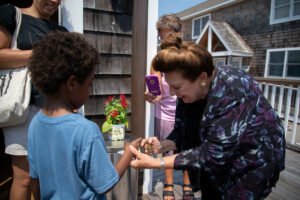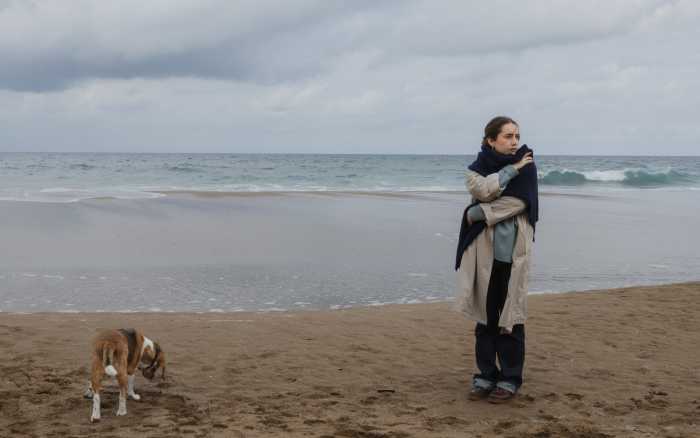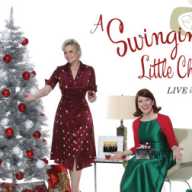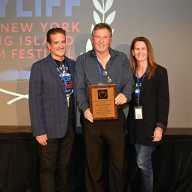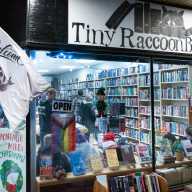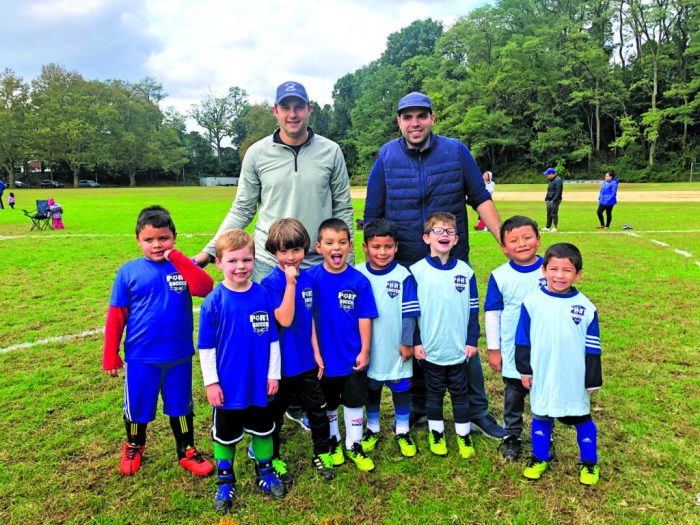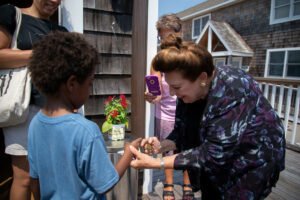
The Ocean Beach Historical Society was embellished with photos of butterflies lining its walls during the “Bountiful Butterflies in our Backyards” event, from Aug. 5-9, 2019. Standing in the gallery was Margot Hofbeck of Seaview, decorated with a Monarch butterfly pin on her left side. She stood holding parsley, dill and milkweed – the host plants of the Eastern Black Swallowtail and Monarch butterflies that emerged from their chrysalises during the event, educating those in the room. Often called “the butterfly lady of Fire Island,” Hofbeck has raised a variety of butterflies from her home in Seaview for 15 years.“
I met her last year, and I thought, everybody should see and hear about what she is doing,” said Linna Salamone, curator of The Ocean Beach Historical Society. “I asked her if she could come and do a lecture for us … it’s wonderful for the camp, and it’s wonderful for the village.” This is the first year the “Bountiful Butterflies in our Backyards” event has taken place. “I am thrilled, I hope we do it again every year,” said Salamone. “She is amazing, and the work she has done is unbelievable, it deserves to be shared.”
Hofbeck previously worked as an animal photographer for the Museum of Natural History. She recently was featured in a series called “How Stuff is Made,” by Refinery29 about Monarch butterflies.
“We have two butterflies here that I have also raised at home,” said Hofbeck. “One is the Monarch, which has become a rare sight. These Monarchs, during their breeding season in September, fly 2,500 miles to Mexico, as fragile and lightweight as they are. The other is the Eastern Black Swallowtail, which lay their eggs on parsley, fennel, carrot tops, and dill. All of the butterflies are careful about laying their eggs on the host plant.”
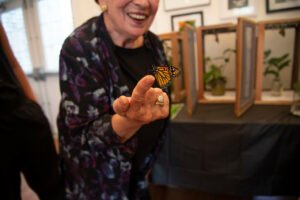
According to Hofbeck, the butterflies each have a different host plant they lay their eggs on. Female butterflies can smell it up to two miles away, and upon landing, can taste it with their feet.“ They do this because they want to ensure they have the proper food for their babies,” said Hofbeck, as she showed me a small, almost opaque pearl looking egg that was laid upon milkweed. “This egg right here is conical, shaped like a pyramid. The eggs all look alike but contain a variety of different types of butterflies.”
Artwork of different butterfly species was on sale at the event by Barbara Geldermann, Matt Jacobs, Joel Silverberg, Erik Schaefer, Lelah Cafuoco, and Hofbeck herself. Hofbeck’s art was available in post cards as well.
“I am a photographer, and I have always loved butterflies,” said Hofbeck. “I became interested in raising them about 15 years ago. When I retired, we started living out here … our first summer I planted a garden. Caterpillars ate all of my parsley and no one knew what they were. Out of curiosity, I decided to keep feeding them parsley and see what happened. When they turned out to be a butterflies, I was hooked.”
The first day of the event, four butterflies emerged. The second day of the event, five emerged, according to Salamone.
“We weren’t sure we were going have any births,” said Salamone. “I am so fortunate that we were able to experience this here.”
Hofbeck said she releases 500 to 800 butterflies from her home every summer.
“When I began, I just was fascinated with the Eastern Black Swallowtail,” said Hofbeck. “I then learned about the Monarchs and their plight, and how important they are to the environment … I wanted to do my part to keep them going. I promote the idea of planting milkweed with everybody.”
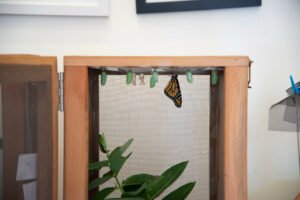
According to the National Wildlife Federation, Monarch caterpillars feed exclusively on the leaves of milkweed. This is the only host plant for this species of butterfly. In its absence, caterpillars cannot complete their life cycle.
“If Monarchs cannot find milkweed, they cannot lay their eggs,” said Hofbeck. “From there, the population will become extinct. It is very important to make sure that milkweed is around. We as individuals make this happen … people need to be taught when mowing the sides of the highways that milkweed should be preserved. Pesticides, mosquito spraying … it all affects insects and butterflies.
”According to a 2015 study commissioned by the U.S. Fish and Wildlife Service, two common chemicals used in mosquito spraying are toxic to butterflies and leave behind lethal effects to their population sizes.
“I usually do this at home, and I have people visit my home all of the time with their kids and their grandkids,” said Hofbeck. “This year when the Historical Society asked me if I would do it here in town, I took the opportunity. While I am here however, I am not taking care of all of the other ones … my kitchen and dining room are filled with butterfly cages and jars.
”Salamone said that the children from Ocean Beach Youth Group came to the show earlier that day. “I showed them the eggs, the caterpillars, and the butterflies that had already been born,” said Hofbeck. “While they were here, we released two butterflies and named them. I love showing children. It is such a joy to watch them participate with science at such a young age.”
Mo Mason of Seaview brought her grandchildren, Mason and Dylan, to visit the show.
“I thought it would be a good rainy day activity for the kids, and educational as well,” said Mason. “I have known Margaret for years. I have seen the work she does in her home, and I knew it would be worth seeing. When I first moved here, I would drive off in the winter and see millions of these Monarchs surrounding the car … now if you see four or five, you feel lucky. It’s a shame.”



